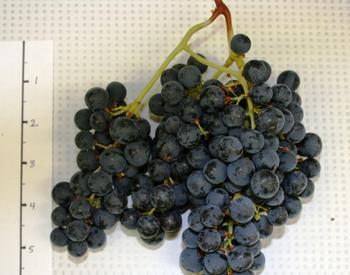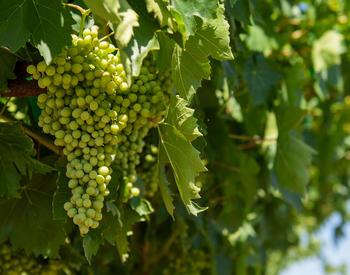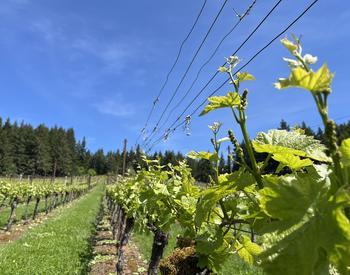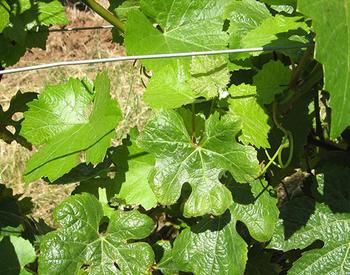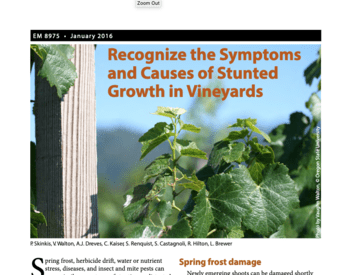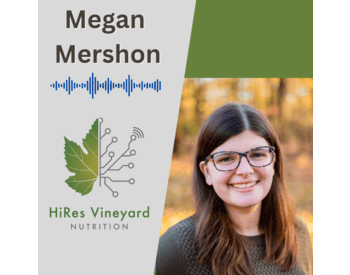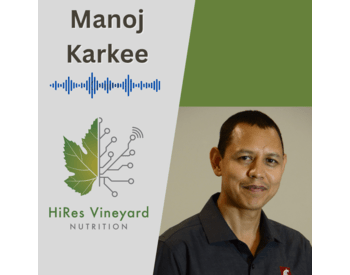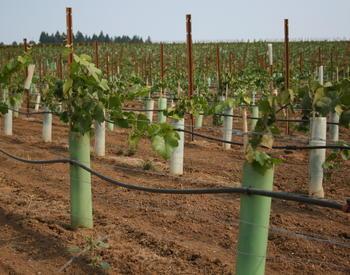Transcript
00:00 Patty Skinkis
This is the HRes Vineyard Nutrition Podcast Series, devoted to helping the grape and wine industry understand more about how to monitor and manage vineyard health through grapevine nutrition research. I am your host, Dr. Patty Skinkis, Professor and Viticulture Extension Specialist at Oregon State University.
00:21 Patty Skinkis
We've talked about plant tissue sampling during a number of our past podcast episodes, and tissue sampling is often done by collecting a number of samples across vineyards. It could be a small number of acres or it could be of quite a large span of acres. The method, in short, is not exacting, and we and at least academia and extension, tell growers to gather a representative sample from the area that they want to evaluate for plant nutrient status, combine them, and send them off to a lab. There's really not a strategic way to get or to suggest a certain number of samples or sampling locations. However, we're hoping to help guide the process of this sampling through the HiRes Vineyard Nutrition Project. Luckily, we have a few teams working on this subject, and joining us today is Manushi Trevidi, a PhD candidate in the lab of Dr. Justine Vanden Heuvel at Cornell University. Manushi has training in remote sensing and earth observation applications for agriculture, and currently she is working to develop better nutrient sampling methods that uses satellite imagery to help guide tissue collections.
Thank you for joining us today, Manushi.
01:34 Manushi Trivedi
Thank you for having me here, Patty.
01:36 Patty Skinkis
Tell me a little bit about yourself and how you got started in precision agriculture research.
01:42 Manushi Trivedi
I've been learning trends and new technologies, specifically the remote sensing, for almost 10 years now. I started my undergraduate education in agriculture information technology in India, and then I was working in industry for almost a year, in regards to how we use such remote sensing for natural resource management. That's how I also got into my master's program in Netherlands. I studied geoinformation science and earth observation for natural resource management. That's how I learned how to map crop areas and crop productivity zones in the sub-Saharan African region. Later on, I joined the program here at Cornell with Dr Justine Vanden Heuvel. That's how I got into agriculture and remote sensing.
02:36 Patty Skinkis
Sounds like you've worked on a number of different cropping systems, or maybe they weren't cropping systems. Can you tell us a little bit about which kind of landscapes, .. you mentioned locations. Can you tell us what kind of landscapes or crops you've worked on?
02:51 Manushi Trivedi
As a part of my master project I've worked in small border farming systems that are less than two hectares, especially small fragmented agricultural landscapes, specifically in Ghana. My project was focused on how to identify those arable land areas that are very diverse and change frequently in time and space. After, I was working not only on edible cropping systems but also on tree crops. I worked on different cropping systems.
03:35 Patty Skinkis
Very neat. How did how did you decide to work in Viticulture or in vineyards? Was it the precision agriculture part of it or did you say I want to work with vineyards specifically?
03:47 Manushi Trivedi
Here's the fun fact. I've worked in viticulture even before my masters, as a part of my undergraduate internship program. I think it was in Tatta Consultancy Services in Mumbai. Then, I was working on how to you use satellite images to proxy the grape sugar content using the different canopy structures and differentiate the grape qualities for the local and export sales. In case you are not familiar with the Maharashtra state located on the west India, it is a huge exporter of the table grapes. My main focus was identifying export versus local quality grapes, and that's how I got into viticulture. After working on diversifying my area within the different copping systems, I came back to viticulture.
04:42 Patty Skinkis
Very interesting to be able to work with quality from that standpoint. I think all of us wish we had that for wine grapes. Can you tell us a bit about the main question of the research that you're doing now at Cornell, within the HiRes Vineyard Nutrition Project?
05:01 Manushi Trivedi
Sure. You would think that usually the extension specialist would recommend to collect a large random sample across the block for each cultivar. But usually, in a real ground scenario, it either has been not done completely or has been done either some sort of prover bias, meaning the samples have been collected over the edges or they picked up 1 or 2 representative rows and sampled across those rows, or sample the healthy versus non-healthy area. However, it's not the ideal way since sometimes it might cost you a lot of losses. So, what I've been trying to understand and find a solution to is called a spatial sampling solution, understanding spatial as any information which is related to the location. What I've been trying to do is to find any other alternative options for such large random samples which could not take such significant amount of time and cost, as well to encourage growers to sample more on a frequent basis. So, rather than going into a whole block across the vineyards, you would rather to go just to one location and get the same level of accuracy of the nutrient quantification by saving the one tenth of the time.
06:30 Patty Skinkis
Basically, you're looking at fewer number of samples,.. less time. So, greater efficiency to be representing that space. I think most growers would love that.
06:342 Manushi Trivedi
I think that so far it has been doing great and I'm really hopeful for this project. I really hope to see that such solutions go into a practical application for people to use it, rather than just being limited to the researchers. That's the ultimate hope.
07:00 Patty Skinkis
This is a great setup, I think, for describing how you come to that conclusion. How do you know when you have the right location and that it's representing a larger area? Can you describe a little bit about how you did the research to come to that conclusion?
07:17 Manushi Trivedi
It has 2 phases; an off-ground and on-ground phase. In the off-ground phase I have used European space agency-based satellite images, called Sentinel 1 and Sentinel 2. Sentinel 2 is a multispectral satellite used to proxy the canopy characteristics, as a proxy of the actual nutrient concentration in the tissues. But, as you would know, it's not only the total nutrient concentration that affects nutrient concentration in the vineyards, but also the bioavailability in the soil. I'm using synthetic Apache Radar Sentinel 1 images to proxies the soil characteristics, specifically soil moisture. I’ve combined these 2 images and divided the vineyard block into different zones, to come up with one junction of such zones which could representative of the sampling location of the whole block. This was the off-ground phase. The on-ground phase has consisted in collecting samples across the Finger Lakes for the last two years with the help of Dr. Marcus Keller’s team from Washington state, Dr. Terry Bate’s team from Cornell Lake Erie regional station and Dr. Matthew Fidelibus from UC Davis from California. So, we have been collecting samples across the commercial blocks and research block as well. We have been collecting large random samples and have been also collecting spatial samples to compare after the errors of how far they are in their quantifications, for example. So, once you have the locations you just need to go there to sample, and if we can claim that this is a good strategy and this spatial protocol is good compared to the large random sampling, then it implies it's a good curve and it can be used as a sampling protocol.
09:32 Patty Skinkis
So, given that the off-ground data; you said one of them is for the soil moisture proxy, and I would imagine that some of these sites have more spatial distribution and that there are differences in their soil type that might lead to differences in moisture content. How frequently are you seeing great diversity in that data? For example, are you seeing that certain locations need more sampling than others?
10:02 Manushi Trivedi
That's the beauty of this spatial sampling protocol. The sample number remain the same, and it’s just the location, the representative location of the block, the one that cover importance. If the variability is much higher in the soil, then the sampling distribution it’s mostly guided by the Sat, and if variability is not so much the soil but the canopy, then sampling distribution it's guided by NDVI. However, in both scenarios the sample number remains the same, being usually 1 sample per location.
10:35 Patty Skinkis
Okay, so it makes sense that if you have greater variability then it leads to less agreement with the model or the sampling strategy you're creating. Ultimately, what we want is to go away from a lot of on-ground measures, but to do the research you have to have them. But, what do you think is the most critical factor to look at in the off-ground measurements? You talked about sentinel 1 and 2, so which parts of all that data do you think is the most crucial in helping you determine a sampling strategy?
11:17 Manushi Trivedi
So far in my part of the analysis, I've found that the soil moisture is playing much higher role compared to the NDVI. I would say the synthetic Apache Radar data is definitely contributing significantly more into the spatial variability of the blocks than NDVI.
11:41 Patty Skinkis
And that stands to reason because more soil moisture implies possibly more plant growth. We would think that would be directly related to and NDVI but not always, so that's interesting. And of course, with more or less soil moisture, you could have more or less nutrient uptake and utilization as well. Also, from of the ground-truthing aspect, what type of samples are you taking. Are you taking leaf blade, petioles, or both?
12:06 Manushi Trivedi
I've been taking only leaf blade, and the main reason behind that is the sensors, the satellite sensors, are sensing leaf blades but the petioles. Plus, I think Dr. Justine Vanden Heuvel was working with Anton Paar and they found that petioles and leaf blades have great variability between each other, however, leaf blades are more accurate than petioles. I would also push for the leaf blades as well.
12:42 Patty Skinkis
That logic stands completely reasonable from his standpoint of satellite imagery measuring the canopy, since we're going to measure what is being sensed. Are you looking at all nutrients or are you just looking at the nitrogen or some of the macronutrients?
12:58 Manushi Trivedi
We are currently doing all the macronutrients, nitrogen, phosphorus, potassium, calcium and magnesium, and micronutrients as well, aluminum, iron, manganese, boron, zinc and sulfur.
13:14 Patty Skinkis
Do you see a good relationship with being able to capture some of the variability within your sampling in multiple nutrients, or you have found a relationship at this point?
13:28 Manushi Trivedi
We have targeted to have less than 1% error from the majority of the nutrients and I've analyzed the past two years of data. It seems like for most of the macronutrients, and I would say all, have less than 5% error when it's compared to the large random sample. However, our micronutrients are a little bit tricky because they are exhibiting more than 5%, approximately 10 to 15% error, which is quite not as we expected.
14:03 Patty Skinkis
I think those micronutrients have become our biggest challenge. They have less of an impact on overall in the plant's physiology, so it's hard to really quantify them. But it's great to hear that you're getting good agreement with your sampling strategy, and hopefully that means that we'll have a good process going forward to recommend to growers. What is the timeline you see on being able to come up with a strategy? Do you think this is something that you already have ready, or what steps do you need to take if you think you need more time?
14:41 Manushi Trivedi
We currently are at the stage where we have already tested them on the research block and this year we are testing them in the commercial block, with the other teams as I've mentioned earlier. I think after this year it's a good to go, if we find it works perfectly for the commercial blocks as well. I'm hoping to have the strategy working and hoping to implement it in MyEv in the future.
15:08 Patty Skinkis
For those listening, the research blocks she mentioned earlier are those from our project collaborators in Washington, California, and New York. How about the commercial blocks? Are they wine grapes, are they in certain states, or is it a combination of different types of grapes?
15:33 Manushi Trivedi
That's a good question. The research blocks do have different types and content of wine grapes up in Lake Erie, and these are the main research blocks. As far as the commercial blocks go, most of them are in the Finger Lakes region and correspond to Riesling and Pinot gris.
16:01 Patty Skinkis
That makes sense to me since these areas are at your closest proximity to be able to do this work. When you do your evaluations--and so, coming up with the research strategy--are you targeting certain time points or are you looking across the entire season? What timing are you using?
16:22 Manushi Trivedi
I've been mainly conducting samples twice in the season, at bloom and at veraison. This is also a standard practice I would say, because at both points, bloom and veraison, it would give to growers enough time to choose nutrient supply. So, since this sampling practice has been adopted for quite a long time, I've been trying to focus these 2 time-points only.
16:48 Patty Skinkis
I'm assuming that you'll target the bloom and the verison time points in the commercial vineyards this year as well.
16:54 Manushi Trevidi
Yes, absolutely!
16:56 Patty Skinkis
Excellent! What are the next steps or further directions that you see from this project carrying it forward?
17:04 Manushi Trivedi
Hopefully, if we are done with our tasting this year, which is the case, then I like to see this as some sort of open plugin incorporated into my efficient manual. The program ran by Dr. Terry Bates at Cornell will incorporate the sentinel images and develop the algorithm on site, which will allow growers to draw their farms boundaries into MyEv, and so have the location to be sampled for nutrients on-hand. That's my vision is for this project.
17:51 Patty Skinkis
I think that's a great vision and gives me an opportunity to talk a little bit about the MyEv. This has come up in other of our episodes. MyEv stands for “my efficient vineyard,” and it is a project that was funded by federal funds and led by Dr. Terry Bates at Cornell, at the Lake Erie location. It's basically an open access software that is used for data visualization and mapping in a vineyard. Currently anybody who wants to can get access to it can get it. You can look up MyEv or efficient vineyard project online, and you'll find it. I know there's efforts underway to get different ways to include data within this platform, and a plugin would be a fantastic tool. I think to be able to suggest to people and guide people where to sample based on their location. Is that currently a plan to develop or is that something looking forward, that you hope will be done?
19:03 Manushi Trivedi
I think it's sort of both, and I really hope that it's definitely a plan. I also hope that it comes through.
19:11 Patty Skinkis
I mean, it's a very practical outcome and you know, and that’s a lot of what this HiRes Vineyard Nutrition Project is about. It is not just coming up with a one-size-fits-all tool. We wanted to come up with tools that would be useful to everybody--large or small acreage growers. And we talked about this in a lot of other episodes, that we don't think that this project is going to come up with tools to completely eliminate the need for nutrient sampling, at least in the near term, and this sampling strategy using remote sensing is an example of a tool that can help us do that nutrient sampling better and more efficiently and more precisely, perhaps.
What do you think are other applications of this work? You're working on a very applied aspect that will have some great outcomes, but what other avenues do you think are worth exploring in this realm, or even other precision agriculture realms that you think are of interest?
20:04 Manushi Trivedi
If we talk about the spatial sampling itself, I would say the broader scope of such applications would be to apply it on a large scale. We are still currently limited to the wine grape production and then block level management, however, I would like to see this sub-sampling protocols get even much more complicated when you do a regional-level analysis. As you know, we are living in a Great Lakes area, so environmental sustainability is definitely a challenge that we all have in the future, from a water quality perspective. We think about how we incorporate such sampling strategies on a large scale to come up with some sort of environmental sustainability at a regional scale, because that's where the remote sensing comes up, since it provides a huge scale of data (a large amount of data) on a frequent basis.
If we don't see the scope of sampling as part of my PhD project, I aim to identify the effect of mycorrhiza fungi on nutritional dynamics. I would like to see and analyze the nutrient content changes due to mycorrhiza, and then see if we can approximate these changes by using remote sensing, specifically hyperspectral reflectance. I see diverse applications for both sampling and non-sampling projects, and the potential of remote sensing and nutrient mapping and monitoring.
21:52 Patty Skinkis
Interesting! You mentioned the mycorrhizal fungi to trying to come up with an association. So, can you tell us a little bit more about that work? I think that's very interesting. Like l you said, that's involved in nutrient acquisition by the roots, so, can you tell us an idea of kind of what you're doing there and what the process is in doing that work?
22:13 Manushi Trivedi
Once you apply the mycorrhizal fungi into the grapes, the fungi actually helps them by doing a symbiotic relationship with the vines. They help to provide nutrient and water to the vines in exchange of carbon, and such association would definitely increase the nutrient concentration in the vines. As mentioned earlier, the nutrient uptake governed by the soil moisture is one of the major factors affecting the nutrient variability, however, it could be also due to mycorrhiza. Here at Cornell I've been working with Dr. Justine and Dr. Katie Gold trying to find whether we can quantify if mycorrhizal change traits in the grapevines, by using hyperspectral reflectance.
23:06 Patty Skinkis
Were you were applying the mycorrhizal fungi to the soil? And was this in established or young vines?
23:15 Manushi Trevidi
I think we have been doing it in a range of vine ages, thus in both young and established ones.
23:23 Patty Skinkis
Very cool! And how many years of work have you completed so far?
23:27 Manushi Trivedi
I would definitely give the credit to Dr. Katie Gold and Dr. Marian Babija and Dr. Jason Londo. They had started working on this even before I came here, so like almost three years now.
23:41 Patty Skinkis
Something for us to look out for. I think you earlier said you're in almost your third year of your PhD project. Where do you think you'll see yourself in the future?
23:55 Manushi Trivedi
I definitely see myself in academia, as I am coming up from the teaching background. My father and my mother are teachers, so I love teaching and I've been teaching from a very young age. So, I definitely see myself in academia, I have learned a lot and hopefully I’ll get a chance in the future to make other people learn something from me. That's where I see myself, but I don't have specifics.
24:24 Patty Skinkis
Is always good to keep an open mind and see what opportunities comes your way. I want to wrap up with a fun question, and it might be two-fold. If you could learn any skill, what would it be and why?
24:40 Manushi Trivedi
I guess maybe learning a language. I'm Indian and I already speak two to three languages, but that makes me realize how languages are important in communicating with different people from different cultures. Not only within the scope of research but also outside of it. So, I would definitely like to learn any of the international language, like French or Spanish. That is something I’d love to do, although I don’t have so much time!
25:20 Patty Skinkis
That's always the challenge when you're working on a graduate degree. You don't have time for anything else, and that's why I thought it was ah a great question. It's one of those things that I think everybody has a skill they want to learn, there's just a matter of time.
The second question I wanted to ask, what is the most interesting or impactful course that you have ever taken in your education?
25:45 Manushi Trivedi
I have so many of them. But the one I could think about, and that's also where I want to see myself in the future, is a course called “local to global impacts”, and I took it during my masters. The course was focused on how the local level actions would impact the global level, and then how the global level policies would shape the behavior changes in people at the local level. It also refers to how can we map such things using remote sensing. For example, I was working on the energy policies of the EU and how it governs the installations of the solar panels. Then the volunteer groups which are working on installing such solar panels for clean and renewable energy. How they how their activity got promoted and then how they were spreading their awareness and how that was it going by. I Really love that course because it gives me the understanding of how procedures and works and affects different scales, and I would hope that it is something I can spend my career doing.
26:59 Patty Skinkis
Based on your two answers, learning multiple languages and local to global impacts, it sounds like we have an Extension academic in the making. You know, I always have to plug the outreach and education and scientific education to the greater public it’s one of the things we do in extension, so you can always keep extension education in the back of your mind.
Thank you so much for joining us today, Manushi. It's been a pleasure learning about you and the research that you're doing as part of the HiRes Vineyard Nutrition Project. For the listeners out there, if you want to learn more about the HiRes Vineyard Nutrition Project, see our website https://highresvineyardnutrition.com, and we're also on Instagram, LinkedIn and Twitter. Thank you!
Getting a representative tissue sample from the vineyard can be challenging without some prior information or knowledge of the vineyard property. In this episode, Manushi Trivedi, Cornell University PhD student, talks about the work they are doing to pin-point where to sample in as few locations as possible to best represent vineyard blocks in nutrient sampling.

